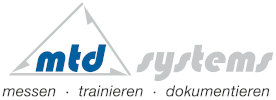FAQs
What is Physiofeedback?
A specific feedback process, used in motoric learing.
Can mtd-Physiofeedbaksystems be used in combination with other applications, e.g. Bobath-concept?
The feedback mtd-Physiofeedbacksystems offer, is exeptionally helpful in motor learing because of it‘s speed and comprehensibility. Utilized in the correct way this „physiofeedback“ improves the effectiveness of many applications e.g. Bobath, Taub or Perfetti essentially.
Are patients with cognitive disorders able to train with mtd-Physiofeedbacksystems?
With it‘s easy to understand presentation, patients with cognitive disorders are still able to exercise successfully, even if they cannot comprehend other training tasks. When observing these patients training, it is easy to see if they did not understand the training exercise or if their current motoric skills just are not good enough to solve the tasks.
How can mtd-Physiofeedbacksystems be used for diagnosis purposes?
mtd-Physiofeedbacksystems offer a variety of possibilities for diagnosis and progress control. With the measurement tool it is possible to measure and display specific movement functions e.g. balance, coordination, force, symmetry of movement, tapping frequence. With a test training further skills e.g. perception, reaction, anticipation or concentration can be evaluated and documented.
There is no visual control doing cognitive therapeutic exercises of Perfetti. Physiofeedback works with a visual feedback displayed on the monitor.
In fact the „motion“ training game for example, with it‘s audible feedback provides the option to perfom exercises of lower extremeties with closed eyes. This exercise supports the body perception extremely and extends the opportunities in therapy of Perfetty considerably.
What is the difference between posturography systems and mtd-balance?
Posturography systems are special equipment for performing equilibrium tests. The mtd-balance, on the other hand, is a multifunctional dual platform for functional measurement, task-oriented training and objective documentation of various movement disorders in the area of physiotherapy, occupational therapy and sports. It is of course,possible to measure different equilibrium functions such as balance, stability and symmetry with the mtd-balance and to use the collected data for equilibrium analysis. The scope of the mtd balance goes far beyond pure equilibrium analysis or posturography. It includes measuring, exercising and documenting simple functions such as seat balance through complex movements such as „bouncing in the knees“ or „bouncing on the toes“ up to the jump analysis. Furthermore, cognitive abilities can also be tested and trained in connection with movement tasks.
What is the difference between vibratory plates like Galileo, Fitvipe, Powerplate, SRT etc. and mtd-balance?
At first glance, the mtd-balance can quickly be confused with the vibration plates of various manufacturers, but all devices have a stand and hold-downs and are used in medicine and sports. While the vibration plates have a motor, which vibrates the platform, the mtd-balance measures the ground reaction forces of the patient or athlete. This completely different technique also results in such a large difference in the application that vibration plates can not be compared with the mtd-balance. In principle, the effect and therefore also the application range of the vibration plates depends on the mechanical influence (shaking, vibrating) and the resulting reactions of the body. The mtd-balance is, on the other hand, a multifunctional dual platform for functional measurement, task-oriented training and objective documentation of movement disorders in the competence area of physiotherapy, occupational therapy and sports.


